Primary Defensive Shotgun
(Requires
Course Registration Form)
This course provides the fundamentals required to deploy a shotgun
effectively in a defensive situation. The shotgun is perhaps the
most efficient and versatile defensive tool in existence. Often
overlooked as low-tech, difficult to use, or just not as sexy
as an AR; the shotgun in the hands of a trained operator with
proper ammunition is extraordinarily formidable. This two-day
course will debunk many of the myths surrounding this weapon system
and demonstrate the extreme utility of the shotgun.
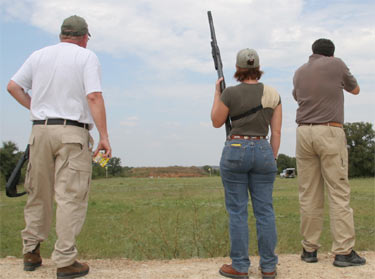
The shotgun is remarkably capable at distances not
usually associated with it. Here Bill Davison and some students
are ringing a 4’ by 4’ gong at 300 yards.
Day one will be principally conducted
in the classroom. Instruction will include comprehensive discussions
on:
- Safety
- The history of the modern defensive shotgun
- Action types and gauges
- Accessorizing the shotgun
- Understanding why different ammunition types are so effective
- Ammunition recommendations
The lecture is followed by a comprehensive range session where the
students pattern their shotgun with various loads at varying distances.
Each shotgun handles specific loads differently and learning which
loads the student’s shotgun patterns well is incredibly important.
The students are also introduced to the fundamentals of efficiently
loading a shotgun beginning with the load one shoot one drill.
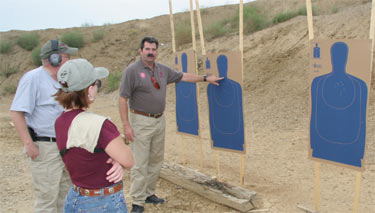

Patterning various loads at different
distances is the only way to become familiar with a particular weapon
and its effective range with a given round.
Day two begins on the one hundred
yard range testing and sighting in with slugs. The targets will
then be moved down to the two hundred yard line to demonstrate that
the shotgun can be used to effectively engage targets at that range.
After returning to the classroom (thirty yards) range to re-confirm
buckshot and slug zeros, the students will practice loading and
shooting on the move drills. From there the students move to one
of the tactical bays to practice shooting on steel plate racks.
It is there that the students learn that they can indeed miss with
a shotgun if excessive speed compromises shooting fundamentals.
Man-on-man contests add pressure to the exercise. Before leaving
the plate racks the students will be introduced to moving and shooting
laterally. Stoppage drills end the second day of training.
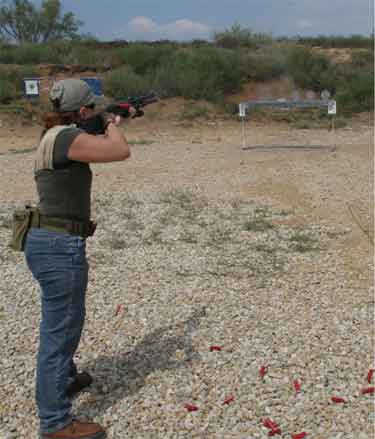
The old saying “you can not possibly
miss fast enough” is true even for the shotgun as demonstrated
during plate rack drills.
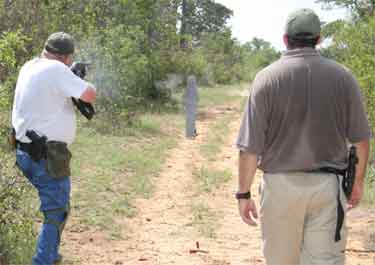
The jungle run is an excellent test of all the fundamentals taught
in the class. Both rousing and enlightening, the jungle run will
expose those areas requiring further practice.
Equipment – Shotgun - New, untested, fresh
from the gunsmith weapons are not recommend. Bring what you carry
or use for home defense. All weapon types are welcome. The 12 gauge
is recommended due to the huge variety of defensive ammunition available
for it. The Remington 870 with a 20” rifled sighted cylinder
bore barrel and a 6 or 7 round magazine extension is the most common
weapon in the class. Any quality pump action or semi-automatic shotgun
is acceptable as long as it functions reliably. 150 rounds of #6
or #7 _ birdshot, 100 rounds of OO buckshot, and 25 slugs are required
as a minimum. We recommend the use of low recoil OO buckshot and
slugs by any of the popular manufacturers, as the maximum loads
tend to be hard on the shooter. A sling is recommended. A sturdy
belt with one or more pouches that can carry between 25 and 50 shot
shells each are recommended.
Equipment – Handgun - New, untested, fresh
from the pistolsmith weapons are not recommend. Bring what you carry.
All weapon types are welcome. We believe that most students are
best served by a standard capacity (13 plus rounds) 9mm pistol.
Fine examples include the Para-Ordinance P18.9, Browning Hi-Power,
Glock models 17, 19, and 34. Loaners are available. Bring a minimum
of 4 hi-cap or 7 single stack magazines. The typical round count
for this class is between 250 and 500 rounds. Be certain that the
ammunition you bring for the course functions well in your weapon
before getting to the class. A sturdy gun belt, kydex or leather
outside the waistband holster, and a double magazine pouch are required.
The weather in north Texas can be extreme. The temperature in the
summer months can exceed 100 degrees. Dress in loose light colored
clothing and wear a wide brimmed hat. During the cooler months the
temperature can range from the low 90s to well below freezing. Be
prepared for anything. We suggest dressing in layers. We shoot rain-or-shine
so bring rain gear. Bring two pair of comfortable shoes in case
one is soaked by rain, mud, or sweat. Kneepads and shooting gloves
will contribute to your comfort. Eye and ear protection are required.
Suntan lotion, Ibuprofen, band-aides, first aide tape, and a lawn
chair are a good idea.
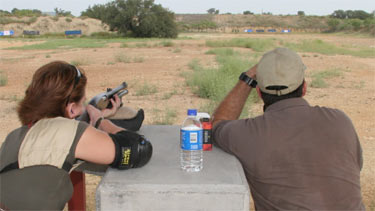
Consistent hits on the 200-yard line are the norm.
The slug has more than ample energy even at that extreme distance
to get the job done.
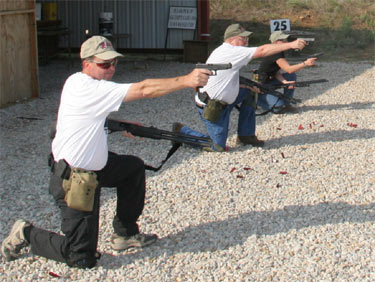
Immediate action drills require rapid transition to a handgun until
time is available to resolve the stoppage of the shotgun.